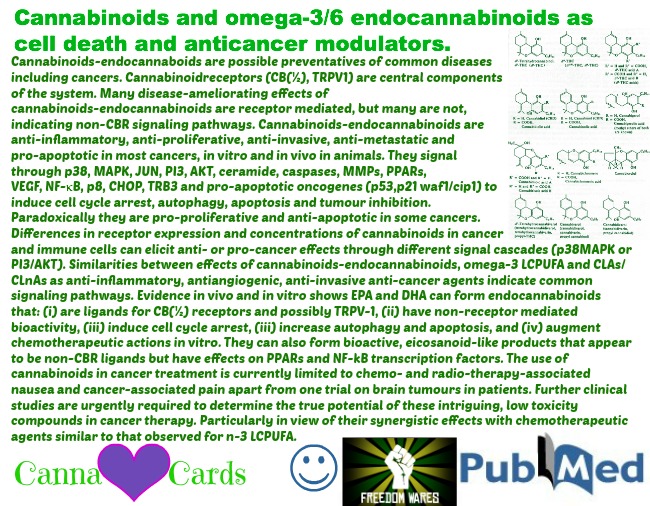 Cannabinoids and omega-3/6 endocannabinoids as cell death and anticancer modulators.
Cannabinoids and omega-3/6 endocannabinoids as cell death and anticancer modulators.
Source
University of Aberdeen, School of Medicine and Dentistry, Cancer Medicine Research Group, Aberdeen, United Kingdom.
Abstract
Cannabinoids-endocannaboids are possible preventatives of common diseases including cancers. Cannabinoidreceptors (CB(½), TRPV1) are central components of the system. Many disease-ameliorating effects ofcannabinoids-endocannabinoids are receptor mediated, but many are not, indicating non-CBR signaling pathways. Cannabinoids-endocannabinoids are anti-inflammatory, anti-proliferative, anti-invasive, anti-metastatic and pro-apoptotic in most cancers, in vitro and in vivo in animals. They signal through p38, MAPK, JUN, PI3, AKT, ceramide, caspases, MMPs, PPARs, VEGF, NF-κB, p8, CHOP, TRB3 and pro-apoptotic oncogenes (p53,p21 waf1/cip1) to induce cell cycle arrest, autophagy, apoptosis and tumour inhibition. Paradoxically they are pro-proliferative and anti-apoptotic in some cancers. Differences in receptor expression and concentrations of cannabinoids in cancer and immune cells can elicit anti- or pro-cancer effects through different signal cascades (p38MAPK or PI3/AKT). Similarities between effects of cannabinoids-endocannabinoids, omega-3 LCPUFA and CLAs/CLnAs as anti-inflammatory, antiangiogenic, anti-invasive anti-cancer agents indicate common signaling pathways. Evidence in vivo and in vitro shows EPA and DHA can form endocannabinoids that: (i) are ligands for CB(½) receptors and possibly TRPV-1, (ii) have non-receptor mediated bioactivity, (iii) induce cell cycle arrest, (iii) increase autophagy and apoptosis, and (iv) augment chemotherapeutic actions in vitro. They can also form bioactive, eicosanoid-like products that appear to be non-CBR ligands but have effects on PPARs and NF-kB transcription factors. The use of cannabinoids in cancer treatment is currently limited to chemo- and radio-therapy-associated nausea and cancer-associated pain apart from one trial on brain tumours in patients. Further clinical studies are urgently required to determine the true potential of these intriguing, low toxicity compounds in cancer therapy. Particularly in view of their synergistic effects with chemotherapeutic agents similar to that observed for n-3 LCPUFA.
Copyright © 2012 Elsevier Ltd. All rights reserved.
Copyright © 2012 Elsevier Ltd. All rights reserved.
- PMID:
23103355
[PubMed – indexed for MEDLINE]
Publication Types, MeSH Terms, Substances
Publication Types
MeSH Terms
- Animals
- Antineoplastic Agents/pharmacology*
- Arachidonic Acids/pharmacology
- Autophagy/drug effects
- Cannabinoid Receptor Agonists/pharmacology
- Cannabinoid Receptor Antagonists/pharmacology
- Cannabinoids/metabolism
- Cannabinoids/pharmacology*
- Cell Death/drug effects
- Cell Proliferation/drug effects
- Endocannabinoids/metabolism
- Endocannabinoids/pharmacology*
- Humans
- Neoplasms/drug therapy
- Neoplasms/metabolism
- Polyunsaturated Alkamides/pharmacology
- Receptor, Cannabinoid, CB2/immunology
- Receptors, Cannabinoid/metabolism*
Substances
LinkOut – more resources
Full Text Sources
Miscellaneous
 Figures and tables from this article:
Figures and tables from this article:
- Fig. 7. Activation of cannabinoid receptor 2 may lead to autophagy and apoptosis by upregulating TRB3, and thereby inhibiting Akt/mTORC1 pathway, or may also initiate autophagy by activating AMPK. (THC = tetrahydrocannabinol, CB2 = cannabinoid receptor 2, CaMKKβ = calcium/calmodulin-dependent protein kinase kinase 2, TRB3 = Tribbles homolog 3, Akt = protein kinase B, AMPK = adenosine monophosphate-activated protein kinase, mTORC1 = mammalian target of rapamycin (mTOR) complex 1).
- Fig. 8. Activation of cannabinoids receptors (or cannabinoids like receptors) is believed to activate map kinase family of proteins (MAPKs), which in turn can activate pro-apoptotic proteins, and inactivate anti-apoptotic proteins. Receptor activation can also inactivate the PI3K/Akt pathway, or COX-2 (CB1/2 = cannabinoid receptor 1/2, VR1 = vanilloid receptor 1, MAPK = mitogen-activated protein kinase, ERK = extracellular signal-regulated kinase, JNK = c-Jun N-terminal kinase, COX-2 = cyclooxygenase 2, BAX∗ = Bcl-2–associated X protein, BCl-2∗∗ = B-cell lymphoma 2, BAD∗ = Bcl-2-associated death promoter, Akt = protein kinase B, PI3K = phosphoinositide 3-kinase, P = phosphorylation, NF-kB = nuclear factor kappa-light-chain-enhancer of activated B cells. ∗ = pro-apoptotic, ∗∗ = anti-apoptotic).
- Fig. 9. Activation of cannabinoids receptors are known to inhibit many processes that lead to cancer cell invasion and metastasis, including pathways that regulate angiogenesis, tumour vascularisation, and tumour cells ability to degrade matrix membranes (CB1/2 = cannabinoid receptor 1/2, VR1 = vanilloid receptor 1, ANGs = angiopoetins, VEGF = vascular endothelial growth factor, PAI-1 = plasminogen activator inhibitor 1, MMPs = matrix metalloproteinases, ICAMs = intercellular adhesion molecules, ID-1 = DNA-binding protein inhibitor 1).

- Corresponding author at: Cancer Medicine Research Group, School of Medicine and Dentistry, 4th Floor, Polwarth Building, Foresterhill, University of Aberdeen, Aberdeen AB25 2ZD, United Kingdom. Tel.: +44 0 1330 860396.
- 1
- Equal first authors.
Copyright © 2012 Elsevier Ltd. All rights reserved.












